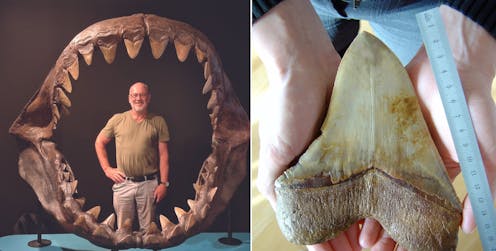How diving as a boy took Tim Flannery on the trail of the megalodon in all its 'terrifying glory'
- Written by Vivienne Westbrook, Adjunct Senior Research Fellow, Oceans Institute, The University of Western Australia

With Meg 2: The Trench[1] currently showing in cinemas – its eponymous star looking unhelpfully like an oversized great white shark – megalodons are having another pop cultural moment.
Cinema-goers may, justifiably, have questions about the accuracy of this latest representation of these prehistoric creatures. The good news is that Tim and Emma Flannery have written a book that will both thrill and inform such curious readers.
Review: Big Meg: The Story of the Largest and Most Mysterious Predator that Ever Lived – Tim Flannery and Emma Flannery (Text Publishing)
Megalodons had cartilaginous structures, rather than the bony skeletons of the dinosaurs. While dinosaurs roamed Earth during the Triassic, Jurassic and Cretaceous periods (from 252 million to 66 million years ago), it is believed the megalodon emerged a mere 23 million years ago.
Megalodons had big, serrated teeth that could cut through large marine animals. When they became extinct, about 3.6 million years ago, palaeontologists were left only with remnants of their toothy smile from which to unpick the story of these sharks.
A palaeontologist by training, Tim Flannery’s prolific literary output has contributed both to academic debate and general awareness-raising about the nature and needs of the planet we continue to dominate. In this latest book, he has combined forces with his daughter, Emma, a scientist and explorer in her own right, but this is very much his story.















